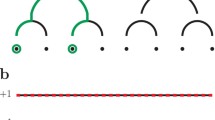Summary
The spin glass phase of a system of Ising spins interacting via the RKKY interaction is investigated at a mean-field level. The results around the transition temperature are at sharp variance with those previously found by other authors and suggest a first-order transition. The static susceptibility is found to deviate from Fischer's predictions. A test of the validity of scaling predictions is also performed.
Riassunto
La fase di ≪spin glass≫ di un sistema di spin di Ising interagenti tramite un'interazione del tipo RKKY è studiata in campo medio. I risultati nell'intorno della temperatura di transizione sono in netto contrasto con quelli in precedenza trovati da altri autori e suggeriscono una transizione del prim'ordine. Si trova che la suscettività statica devia dalle predizioni di Fischer. Si effettua anche una verifica della validità delle leggi di scala.
Резюме
На уровне среднего поля исследуется фаза спинового стекла для системы спинов Изинга, взаимодействующих через RKKY взаумодействие. Полученные результаты для температуры перехода сильно отличаются от результатов, полученных ранее другими авторами, и предполагают переход первого порядка. Обнаружено, что статическая восприимчивость отличается от предсказаний Фишера. Также проводится проверка справедливости предсказаний подобия.
Similar content being viewed by others
References
S. F. Edwards andP. W. Anderson:J. Phys. F,5, 965 (1975).
D. Sherrington andS. Kirkpatrick:Phys. Rev. Lett.,35, 1972 (1975);Phys. Rev. B,17, 4384 (1978).
D. J. Thouless, P. W. Anderson andR. G. Palmer:Philos. Mag.,35, 593 (1977).
J. R. L. de Almeida andD. J. Thouless:J. Phys. A,11, 983 (1978).
J. L. van Hemmen andR. G. Palmer:J. Phys. A,12, 563 (1979).
G. Parisi:J. Phys. A,13, 1103 (1980), and references quoted therein;Proceedings of the International Conference on Disordered Systems and Localization, Rome, May 1981, to be published.
G. Parisi andG. Toulouse:J. Phys. (Paris) Lett.,41, L361 (1980).
J. Vannimeus, G. Toulouse andG. Parisi:J. Phys. (Paris),42, 565 (1981).
W. Marshall:Phys. Rev.,118, 1519 (1960).
M. W. Klein andR. Brout:Phys. Rev.,132, 2412 (1963).
M. W. Klein:Phys. Rev.,173, 552 (1968);Phys. Rev. B,14, 5008 (1976).
I. Riess andM. W. Klein:Phys. Rev. B,15, 6001 (1976).
M. W. Klein, L. J. Schowalter andP. Shukla:Phys. Rev. B,19, 1492 (1979).
G. Corbelli andG. Morandi:Solid State Commun.,29, 589 (1979)
—:Nuovo Cimento B,54, 129 (1979).
Equation (2) was derived by using, as in the rest of the literature, a short-distance cut-offd on the interaction, chosen here for simplicity to be such that 2k F d∼1, whence the lower bounds of integration in eqs. (3) and (4). One might dispense from the cut-off by using the full form of the RKKY interaction,i.e. by writing (x cosx−sinx)/x 4 in place of (cosx)/x 3 in the above equations and setting the lower bounds of integration to zero. However, the original physical problem being formulated on a lattice, the use of a cut-off of the order of the lattice parameter seems to be more natural.
G. Corbelli andG. Morandi:Physica D (The Hague),3, 590 (1981).
W. Kinzel andK. H. Fischer:J. Phys. C,11, 2115 (1978).
K. H. Fischer:Phys. Rev. Lett.,34, 1438 (1975).
In a cut-off-free treatment (see footnote (15)) Equation (2) was derived by using, as in the rest of the literature, a short-distance cut-offd on the interaction, chosen here for simplicity to be such that 2k F d∼1, whence the lower bounds of integration in eqs. (3) and (4). One might dispense from the cut-off by using the full form of the RKKY interaction,i.e. by writing (x cosx−sinx)/x 4 in place of (cosx)/x 3 in the above equations and setting the lower bounds of integration to zero. However, the original physical problem being formulated on a lattice, the use of a cut-off of the order of the lattice parameter seems to be more natural. one would instead obtain Γ(0)=−1.
J. Souletie andR. Tournier:J. Low Temp. Phys.,1, 95 (1969).
Author information
Authors and Affiliations
Rights and permissions
About this article
Cite this article
Corbelli, G., Lovecchio, G. & Morandi, G. Order parameter and static susceptibility of spin glasses in mean-field theory. Il Nuovo Cimento D 1, 225–234 (1982). https://doi.org/10.1007/BF02450081
Received:
Issue Date:
DOI: https://doi.org/10.1007/BF02450081



